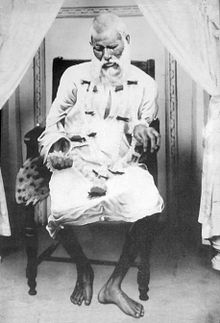Tajuddin Muhammad Badruddin
Syed Mohammad Tajuddin | |
|---|---|
 | |
| Born | January 27, 1861 Kamthi, British India |
| Died | August 17, 1925 (aged 64) Nagpur, India |
| Era | Modern era |
| Region | Islamic philosophy |
| School | Sufism |
Main interests | Quran reading |
show
Influences | |
show
Influenced | |
Syed Mohammad Baba Tajuddin (January 27, 1861 – August 17, 1925), also known as Tajuddin Baba, was an Indian Sufi Master who is considered as the Qutb.[1] His shrine is in Nagpur, India.[2]
Birth[]
Tajuddin Baba was born in 1861 (1277 AH) to the family of Imam Hassan, being a tenth-generation descendant of the founder of the world Sufi Naqshbandi order, Baha-ud-Din Naqshband Bukhari, and a 22nd-generation descendant of the eleventh imam, Hasan al-Askari.[3][4][5][6] Baba's forefathers had migrated from Mecca and settled down in Madras, India. His father was an employee in military.[7]
Early life[]
Baba Tajuddin was orphaned at a young age and raised by his maternal grandmother and uncle Abdul Rahman. He attended a madrasah in Kamthi, Nagpur.[8] There he met Abdulla Shah Naushahi who initiated him into the spiritual path.[9]
Abdullah Shah Hussaini Qadri Shuttari Sahib[clarification needed] who was a Majzoob Salik saint from Qadri Shuttari Sufi order commented (about Baba) to his teacher that "There is no need of teaching this boy, he is already a learned person." He also gave young Tajuddin Baba some dried fruits and nuts as his blessings for Baba, which is said to put the young boy into an ongoing spiritual trance-like state. Baba completed his education and studied Urdu, English, Arabic and Persian.[10]
Successors[]
Baba Tajuddin had several caliphs whom he had appointed to serve others over the course of his lifetime. However, his key successor was Molana Abdul Kareem Shah, who Baba Tajuddin named "Yousuf Shah" and called him his son. The name Yousuf, gives an indication to his life story being similar to that of Prophet Yousuf. This is also the point where Yousufi Silsila (Sufi Chain) came into existence. Baba Yousuf Shah's body is buried in Mewashah Darga, Karachi, Pakistan in October 1947. And much before his own passing away, he had named one of his younger disciples, Kunwar Asghar Ali Khan as the next successor (Jaan Nasheen). Kunwar Asghar Ali Khan became known as "Albelay Shah Yousufi", and Zaheen Shah Taji was named as the caretaker (Sajjada Nasheen) to Yousuf Shah Baba's mausoleum.Times of India says Aala Hazrat Jalaluddin Mir Surkh of Meetha Neem Dargah was the disciple of Tajuddin Baba. Among the several caliphs of Hazrat Baba Tajuddin another famous name is Hazrat Ghulam Mustafa, To whom Baba Tajuddin gave a title of”Miskeen Shah”. Hazrat Ghulam Mustafa (Baba Miskeen Shah) shrine located in Sikandrabad, District Bulandshahar, Uttar Pradesh.[11]
Names and titles[]
According to author Bhau Kalchuri, baba Badruddin was born Tajuddin Muhammad Badruddin.[2] Tajuddin says his real name is Syed Muhammad Tajuddin, and he is also known as Chiragh din (The light of religion). He is also known as Baba Tajuddin of Nagpur, Sayyad Mohammad Tajuddin, and Syed Mohammed Baba Tajuddin Aulia.
Some other titles that are associated with Baba Tajuddin are:
- Tajul Auliya
- Tajul Millatay Waddeen
- Shahensha-Ay Haftaqleem
- Paiyambar-e-Zahra
Gallery[]
Images of the shrine of Tajuddin in Nagpur.
Notes[]
Annual Urs of the saint is celebrated on the Saint's Shrine known as tajuddin Baba Urs.
References[]
- ^ Taji, Zaheen Shah: Tajul Auliya, Volume II, Taj Publication, 1971, p. 221
- ^ Jump up to: a b Kalchuri, Bhau: Meher Prabhu: Lord Meher, Volume One, Manifestation, Inc., 1986, p. 46
- ^ "Maqolalar". 3 August 2017. Archived from the original on 3 August 2017. Retrieved 15 May 2021.
- ^ "Tasavvuf Ahli". 3 August 2017. Archived from the original on 3 August 2017. Retrieved 15 May 2021.
- ^ Taji, Taj (5 February 2012). "lineage". Retrieved 15 May 2021.
- ^ "Shajara-e-nasab lineages of descendants of Imam Hasan al-Askari r.a.-Shajara.org". Retrieved 29 June 2020.
- ^ Bharucha, Ruzbeh N. (1 April 2015). The Perfect Ones. Penguin UK.
- ^ Kalchuri, Bhau: Meher Prabhu: Lord Meher, Volume One, Manifestation, Inc., 1986, p. 47
- ^ Khurshid, Zahiruddin (28 June 2013). From Kamptee to Dallas: One Information Professional's Journey Across Cultural Boundaries (India, Pakistan, Saudi Arabia, and United States). ISBN 978-1-4836-3724-2.
- ^ Taji, Zaheen Shah (1956). Tajul Auliya (2nd ed.). Karachi: Taj Company. p. 43.
- ^ "Qawwalis mark Sufi saint's Urs at Meetha Neem Dargah | Nagpur News - Times of India". The Times of India. 20 April 2017. Retrieved 15 May 2021.
External links[]
| Wikimedia Commons has media related to Tajuddin Baba. |
- Indian Islamic religious leaders
- People from Nagpur
- Husaynids
- Indian Sufi saints
- 1861 births
- 1925 deaths
- 19th-century Indian Muslims
- 19th-century Indian people
- 19th-century Indian philosophers
- 19th-century Indian scholars
- 20th-century Indian Muslims
- 20th-century Indian philosophers







